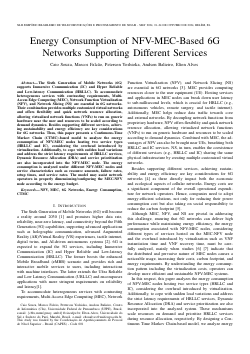
Energy Consumption of NFV-MEC-Based 6G Networks Supporting Different Services
Caio B. B. Souza, Marcos Falcão, Peterson Marcelo Santos Yoshioka, Andson M Balieiro, Elton Alves
DOI: 10.14209/sbrt.2024.1571036267
Evento: XLII Simpósio Brasileiro de Telecomunicações e Processamento de Sinais (SBrT2024)
Keywords: NFV-MEC 6G Netwoks Energy Consumption CMTC
Abstract
The Sixth Generation of Mobile Networks (6G) is support Immersive Communication (IC) and Hyper Reli- able and Low-latency Communication (HRLLC). To accommodate heterogeneous services with contrasting requirements, Multi-Access Edge Computing (MEC), Network Function Virtualization (NFV), and Network Slicing (NS) are essential in 6G networks. Their combination provides multiple customized virtual networks and offers flexibility and quick network resource allocation, allowing virtualized network functions (VNFs) to run on generic hardware near the user and resources to be scaled according to demand dynamics. Besides supporting different services, achieving sustainability and energy efficiency are key considerations for 6G networks. Thus, this paper presents a Continuous-Time Markov Chain (CTMC)-based model to analyze the energy consumption of NFV-MEC nodes hosting two service types (HRLLC and IC), considering the overhead introduced by virtualization. Additionally, to cope with sudden load variations and address the strict latency requirements of HRLLC services, Dynamic Resource Allocation (DRA) and service prioritization are also incorporated into the NFV-MEC node. The energy consumption is analyzed under different NFV-MEC node and service characteristics such as resource amounts, failure rates, setup times, and service rates. The model may assist network operators in properly dimensioning/configuring the MEC-NFV node according to the energy budget.Download